â€å“ollaã¢â‚¬â a Soup Made With Beef Broth, Squash, Yucca and Common Central American Vegetables.
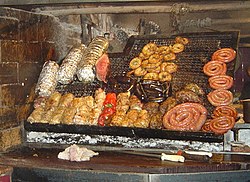
Latin American cuisine is the typical foods, beverages, and cooking styles common to many of the countries and cultures in Latin America. Latin America is a highly various surface area of state whose nations have varying cuisines. Some items typical of Latin American cuisine include maize-based dishes arepas, pupusas, tacos, tamales, tortillas and various salsas and other condiments (guacamole, pico de gallo, mole, chimichurri, chili, aji, pebre). Sofrito, a culinary term that originally referred to a specific combination of sautéed or braised aromatics, exists in Latin American cuisine. It refers to a sauce of tomatoes, roasted bell peppers, garlic, onions and herbs. Rice and beans are also staples in Latin American cuisine.
Latin American beverages are just as distinct every bit their foods. Some of the beverages can fifty-fifty date back to the times of the Native Americans. Some pop beverages include java, mate, hibiscus tea, horchata, chicha, atole, cacao and aguas frescas.
Desserts in Latin America are generally very sweet in taste. They include dulce de leche, alfajor, rice pudding, tres leches cake, teja and flan.
Cultural influences [edit]
Native American influence [edit]
Information about Native American cuisine comes from a groovy variety of sources. Modern-day Native peoples retain a rich torso of traditional foods, some of which have become iconic of present-twenty-four hour period Native American social gatherings (for example, frybread). Foods like cornbread are known to take been adopted into the cuisine of the United States from Native American groups. In other cases, documents from the early on periods of contact with European, African, and Asian peoples allow the recovery of nutrient practices which passed out of popularity in the historic period (for example, black drink). Archaeological techniques, particularly in the subdisciplines of zooarchaeology and paleoethnobotany, have allowed for the agreement of other culinary practices or preferred foods which did not survive into the written celebrated record. The primary crops Native Americans used in United mexican states and Primal America were corn and beans, which are used in contemporary dishes such every bit pupusas, tamales, pozole, chuchitos, and corn tortillas. The main Native American crops used by Natives of South America were potatoes, corn and chuño, used mainly in modern-day Colombian, Ecuadorian, Peruvian, Chilean, Bolivian and Paraguayan dishes such as arepas, papa a la huancaína, humitas, chipa guasu, locro and many more.
African influence [edit]
Africans brought and preserved many of their traditions and cooking techniques. They were often given less desired cuts of meat, including shoulder and intestines. Menudo, for example, was derived from the addiction of the Spaniards of giving the slaves cow'south intestines. Enslaved Africans developed a way to make clean the offal and flavour it to taste. African slaves in the southern Us did the same affair with pig's intestines, creating the dish known today as chitterlings. In South America, the scraps of nutrient the landlords did not eat were combined to create new dishes that nowadays have been adopted into the cuisines of their respective nations (such as Peruvian tacu-tacu) and (Ecuadorian guatita).
European influence [edit]
Europeans brought their culinary traditions, simply chop-chop adapted several of the fruits and vegetables native to the Americas into their own cuisines. Europe itself has been influenced by other cultures, such every bit with the al-andalus in Spain, and thus their nutrient was already a mix of their earth. The European influence for many Latin American cuisine mainly comes from Espana, Portugal, Italia, and to a lesser extent France, although some influences from cuisines as diverse as British, German and Eastern European are as well axiomatic in some countries' cuisines such as Argentina and Uruguay, which have Italian cuisine equally a main influence, with great Spanish, British, German language, Russian, French, and Eastern European influence as well.
Asian influence [edit]
A wave of immigrants from Asia, such equally China and Japan, also influenced the cuisine of Perú, Brazil, Panama, and Ecuador. The Chinese brought with them their own spices and food-styles, something that the people of Latin America accepted into their tables. Not but that, but several Asian restaurants also adjusted many Latin American food-styles into their own. This case can clearly be seen in the Peruvian and Ecuadorian chifa. Other countries in Latin America such equally Uruguay and Argentina have adapted Armenian and Israeli cuisine due to mass immigration from those countries to Argentine republic and Uruguay. The high Lebanese presence in certain South Americans countries has made some Lebanese foods like kibbeh a common staple.
North America [edit]
North American cuisine is a term used for foods native to or popular in countries of N America, as with Canadian cuisine, Cuisine of the United States, Cuisine of the Caribbean, Cuisine of Cardinal America, and Cuisine of United mexican states. It has influences from many international cuisines, including Native American cuisine and European cuisine.
The cuisines of nearby Central America and the Caribbean region – sometimes grouped with the North American continent – may be considered part of North American cuisine in the technical sense that they are not assigned to their own continents.
Caribbean [edit]
Caribbean cuisine is a fusion of Amerindian, African and European cuisine. These traditions were brought from the many homelands of this region's population. In addition, the population has created from this vast wealth of tradition many styles that are unique to the region.
Seafood is one of the almost common cuisine types in the islands, though this is certainly due in part to their location.[ane] Each island will likely have its ain specialty. Some prepare lobster, while others adopt certain types of fish. For example, the island of Barbados is known for its "flying fish."
Another Caribbean mainstay is rice, but the rice on each island may exist a little unlike. Some flavor their rice, or add peas and other ingredients such as coconut. Sometimes the yellow rice is served equally a side, only it is oftentimes part of a dish. Though it comes in many forms, information technology is a common side dish throughout the region.
Republic of cuba [edit]
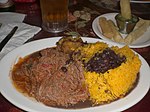
Cuban cuisine is a distinctive fusion of Spanish, African and Caribbean cuisines. Cuban recipes share their basic spice palette (cumin, oregano, and bay leaves) and preparation techniques with Castilian and African cooking. The black Caribbean area rice influence is in the use of local foods such every bit tropical fruits, root vegetables, fish, etc. A small but noteworthy Chinese influence is the daily use of steamed white rice every bit the main carbohydrate in a traditional Cuban meal. Rice is essential to a Cuban meal. It is usually eaten during dejeuner and dinner well-nigh every twenty-four hours.[2]
Dissimilar nearby Mexico and Central America which have tortillas in their cuisines, the but resemblance to the use of tortillas is with casave, dating from pre-Columbian ethnic times which is chosen Casave. This flatbread is produced past grinding yuca (cassava) root to class a paste which, when mixed with h2o, becomes a dough. This is lightly cooked as a apartment round deejay and air-dried to preserve information technology for consumption for a afterward time. It is traditionally reconstituted in salt water and eaten with roasted pork. The other culinary marvel is a regional dish consisting of a roasted rodent uniquely found in Cuba, jutia (Desmarest's hutia).
Dominican Republic [edit]

Mangú is a popular dish with origins in Africa and its fufu.
The cuisine of the Dominican Republic, much like its neighbors, is a fusion of Indigenous (Taino), Spanish, and African cuisines. All or nearly all nutrient groups are accommodated in typical Dominican cuisine, as information technology incorporates meat or seafood; grains, particularly rice, corn, and wheat; vegetables, such as beans and other legumes, potatoes, yuca, or plantains, and salad; dairy products, specially milk and cheese; and fruits, such as oranges, bananas, and mangos. Notwithstanding, there is heaviest consumption of starches and meats, and to the lowest degree of dairy products and non-starchy vegetables. Differences betwixt Dominican cuisine and those of other parts of the West Indies include the milder spicing, which mainly uses onions, garlic, cilantro, cilantro ancho (culantro), ají cubanela (cubanelle pepper), and oregano.
Sofrito, locally known as sazón, a sautéed mix including local herbs and spices, is used in many dishes. Throughout the south-central coast bulgur, or whole wheat, is a main ingredient in quipes and tipili, two dishes brought by Levantine Middle Eastern immigrants. Other favorite foods and dishes include chicharrón, yautía, pastelitos or empanadas, batata (sugariness potato), pasteles en hoja (ground roots pockets), chimichurris, plátanos maduros (ripe plantain), yuca con mojo (boiled yuca/cassava) and tostones/fritos (fried plantains
Cuisine also varies due to geographical areas. In general, well-nigh Dominican meat dishes tend to involve pork, as pigs are farmed quite heavily on the isle. Meat dishes tend to exist very well cooked or even stewed in Dominican restaurants, a tradition stemming from the lesser availability of refrigeration on the island. Seaside Dominican fishing villages will have neat varieties of seafood, the most mutual being shrimp, marlin, mahi-mahi or dorado, and lobster. Nigh villagers more than commonly dine on cheap, lesser-quality fish, ordinarily stewed with la criolla, a type of rice. Premium seafood tends to be likewise expensive for the many locals, and is saved for the island'due south upper class and the tourist resorts.
Haiti [edit]

A table setting of Haitian nutrient
Haitian cuisine is a mixture of various cuisines, predominately of a like nature with fellow Latin American countries. In addition to native Taino cooking, French and Castilian colonization in concordance with the introduction of African slaves heavily influenced the culinary practices of Haiti. For example, a staple food of major Haitian cities (east.g. Port-au-Prince) is French baguettes. The French and Castilian brought Roman Catholicism along with them, so the Haitian nutrient calendar follows that of the Cosmic tradition. For example, soup joumou (also known as giraumon soup) is served on New year's day's Day. Joumou is a pumpkin soup made with salt beefiness and seasoned with nutmeg and other spices.[3] Haitians swallow traditional foods (e.g. benye, white beans, kremas) in excess on banquet days. Poorer areas, which were more impacted past the immigration of Syrians and the Lebanese in the 19th century, popularized Hurting Haitien. Slaves created various popular Haitian dishes such as pain patate, akra de mori, and thiaka. Other staple foods are rice (diri), other grains, and millet (piti mii) for the poor. All of these foods are usually in every repast along with beans. Poultry is far more popular than pork or meat; however, the majority of the protein provided in a Haitian diet is from rice and beans. Some foods are regional staples. Seafood, while popular everywhere, has a heavy cultural influence on declension towns. Fruits and nuts from the mountains of Haiti are exported across that region of the island, providing Haitians with delicious and healthy drinks and desserts.[2] Though similar to other cuisine in the region, information technology carries a uniqueness native only to the country and an appeal to many visitors in the island.
Puerto Rico [edit]

Puerto Rican cuisine has its roots in the cooking traditions and practices of Europe (Kingdom of spain), Africa, and the Amerindian Taínos.
When in 1493 Spanish colonizers began a period of bully alter on the islands. The Spanish introduced foods from effectually the world including Europe, Asia, and Africa. They realized that not all the food they introduced to this new location were viable. And so, while they had to abandon some of what was primal to their home country, they began to discover the local assets such equally pigs and cattle. Still, some of what the Spaniards brought to Puerto Rico became of great importance to modern traditional dishes such as plantains, bananas, and coffee; all of which are now prominent in current Puerto Rican food civilisation.[5]
In the latter part of the 19th century the cuisine of Puerto Rico was profoundly influenced by the United States in the ingredients used in its preparation. Puerto Rican cuisine has transcended the boundaries of the island and can be found in several countries exterior the archipelago . Many crops cultivated in Puerto Rico stem from New World origins like plantains.[6]
Chef Doreen Colondres celebrates Puerto Rican and Latin American cuisine more broadly in her goggle box segments and her cookery volume.[seven] [8]
Cardinal America [edit]
Central American cuisine is a fusion of Indigenous, Spanish and African influence.[ix] Most of the countries are inside the Mesoamerica cultural and celebrated region. Some of its staple foods, such as maize, bell peppers, squash, beans, and tomatoes originated and are native to the region and overtime take become basic staples in other international cuisines around the world.[10]
Its cuisine varies with its geographical areas, also as its demographics. In the Pacific coasts of the countries in Central America, the influence of its nutrient are more of a Indigenous and European infusion. In the Caribbean area declension the fusion is more of a Indigenous and African fusion. The exception being El salvador and Belize, where they are the other two countries that do not border both the Pacific and Caribbean. Nevertheless, their cuisines still possess a fusion of all three cuisines because of their, and their neighboring countries' demographics.
Another staple in both Pacific and Caribbean area cuisine of the area is rice. It is accompanied by a meat (pork, beef, and chicken), or seafood. Dishes mixed with rice are mutual throughout the region, an example being gallopinto. The Caribbean coasts of Central America also take a more than heavy usage of dishes containing coconut (milk, oil, etc.).
Costa Rica [edit]

The main staple, known as gallo pinto (or simply pinto), consists of rice and blackness beans, which in many households is eaten at all three meals during the mean solar day.
Other Costa Rican food staples include corn tortillas, white cheese and picadillos. Tortillas are used to accompany most meals. Costa Ricans will often fill their tortillas with any they are eating and consume information technology in the course of a gallo (direct translation: rooster, however, it resembles a soft Mexican taco). White cheese is not-candy cheese that is made by adding salt to milk in production. Picadillos are meat and vegetable combinations where ane or more vegetables are diced, mixed with beef and garnished with spices. Common vegetables used in picadillos are potatoes, light-green beans, squash, ayote, chayote and arracache. Ofttimes, picadillos are eaten in the form of gallos.
El Salvador [edit]

Salvadoran cuisine is a manner of cooking derived from the nation of El Salvador. The traditional cuisine consists of food from the Pipil people, with a European twist in most modernistic dishes. Many of the dishes are made with maize (corn).
El Salvador'due south almost notable dish is the pupusa, a thick hand-made corn flour or rice flour tortilla stuffed with cheese, chicharrón (fried pork rinds), refried beans or loroco (a vine flower bud native to Central America). There are also vegetarian options, often with ayote (a type of squash), or garlic. Some adventurous restaurants even offering pupusas stuffed with shrimp or spinach.
Ii other typical Salvadoran dishes are yuca frita and panes rellenos. Yuca frita, which is deep fried cassava root served with curtido (a pickled cabbage, onion and carrot topping) and pork rinds with pescaditas (fried baby sardines). The yuca is sometimes served boiled instead of fried. Panes con Pavo (turkey sandwiches) are warm turkey submarines. The turkey is marinated and then roasted with Pipil spices and handpulled. This sandwich is traditionally served with turkey, tomato, and watercress along with cucumber, onion, lettuce, mayonnaise, and mustard. A lot of Salvadoran nutrient is served with French bread, or pan frances in Spanish.
Guatemala [edit]

Fiambre, a traditional dish eaten in Nov. It consists of over 50 ingredients.
The cuisine of Guatemala reflects the multicultural nature of Guatemala, in that it involves food that differs in taste depending on the region. Guatemala has 22 departments (or divisions), each of which has very different typical foodstuffs. Guatemalan cuisine is widely known for its candy originating from Antigua Guatemala.
In that location are too foods that information technology is traditional to consume on certain days of the week - for example, by tradition it is known that on Thursday, the typical food is "paches" which is like a tamal made with a base of potato, and on Saturday it is traditional to eat tamales.
Republic of honduras [edit]
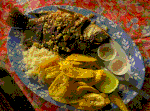
Honduran Cuisine combines Spanish, Caribbean, and pre-Columbian influences of the ethnic Maya-Lenca population. Its most notable feature is that it uses more coconut than any other Central American cuisine in both sugariness and savory dishes. Regional specialties include pollo con tajadas (fried chicken with fried green banana chips) fried fish, carne asada, and baleadas. Platano maduro fritos with sour creme are as well a common dish.
In addition to the baleadas, the following are also popular: meat roasted with chismol carne asada, chicken with rice and corn, fried fish (Yojoa style) with encurtido (pickled onions and jalapeños). In the coastal areas and in the Bay Islands, seafood and some meats are prepared in many ways, some of which include coconut milk.
Amid the soups the Hondurans enjoy are: conch soup, bean soup, Mondongo soup, or soup of intestine, seafood soups, beefiness soups, all of which are mixed with plantains, yuca, cabbage amid other things, and complemented with corn tortillas.
Other typical dishes are the montucas or corn tamale, stuffed tortillas, tamales wrapped up with banana leaves, among other types of nutrient. Also part of the Honduran typical dishes are an abundant selection of tropical fruits such every bit: papaya, pineapple, plums, epazotes, passionfruits, and a wide diversity of bananas and plantains which are prepared in many ways.
Nicaragua [edit]

Baho, a traditional dish in Nicaragua.
The Cuisine of Nicaragua is a fusion of Spanish, Caribbean and pre-Columbian dishes of the indigenous peoples. When the Spaniards commencement arrived in Nicaragua they institute that the indigenous peoples had incorporated foods bachelor in the area into their cuisine.[11] Despite the blending and incorporation of pre-Columbian and Spanish influenced cuisine, traditional cuisine changes from the Pacific to the Caribbean coast. While the Pacific coast'south primary staple revolves around fruits and corn, the Caribbean coast makes utilize of seafood and the coconut.
As in many other Latin American countries, corn is a chief staple. Corn is used in many of the widely consumed dishes, such as nacatamal, and indio viejo. Corn is too an ingredient for drinks such as pinolillo and chicha as well as in some sweets and desserts. Locally grown vegetables and fruits have been in utilize since before the inflow of the Spaniards and their influence on Nicaraguan cuisine. Many of Nicaragua's dishes include fruits and vegetables such every bit jocote, grosella, mimbro, mango, papaya, tamarind, pipián, banana, avocado, yuca, and herbs such as cilantro, oregano and achiote.[11]
Gallo pinto is Nicaragua's national dish, consisting of reddish beans and rice. The dish has several variations including the add-on of kokosnoot oil or grated coconut which is primarily prepared on Nicaragua's Caribbean declension. It is thought to take originated in Nicaragua; even so, there is some controversy virtually the origins of this dish.
Panama [edit]

Panamanian sweets such every bit Huevitos de Leche, Bocadillos, and Manjar blancos
Panamanian cuisine has its own unique and rich cuisine. As a land span betwixt two continents, Panama is blessed by nature with an unusual variety of tropical fruits, vegetables and herbs that are used in native cooking. Also, as a crossroads of the earth catalyzed by the Panama Canal, Panamanian cuisine is influenced by its various population of Hispanic, native Indian, European, African, Colombian, Jamaican, and Chinese migration. A common Panamanian diet includes seafood such equally crab, lobster, and squid, many versions of chicken soup, and vast amounts of fruit such as papayas, coconuts, and bananas.[12] They likewise drink chicha, a very common drink found in Panama.
United mexican states [edit]

Mexican cuisine is a style of food which is primarily a fusion of indigenous Mesoamerican cooking with European (especially Castilian) cooking developed after the Spanish conquest of the Aztec Empire. The basic staples remain the native corn, beans and chili peppers simply the Europeans introduced a large number of other foods, the virtually important of which were meat from domesticated animals (beef, pork, chicken, goat and sheep), dairy products (specially cheese) and diverse herbs and spices.[13] While the Spanish initially tried to superimpose their diet on the country, this was not possible thanks largely to Mexico's highly adult indigenous cuisines. Instead, the foods and cooking techniques of both the indigenous Mexicans and the Spanish began to exist mixed contributing to the development of an fifty-fifty more than varied and rich cuisine. Over the centuries, this resulted in various regional cuisines, based on local conditions such as those in the due north, Oaxaca, Veracruz and the Yucatán Peninsula. Mexican cuisine is highly tied to the culture, social structure and its popular traditions, the nearly important case of which is the use of mole for special occasions and holidays, particularly in the S region of the country. For this reason and others, Mexican cuisine was added by UNESCO to its list of the world'due south "intangible cultural heritage".[14]
Mexican-Americans in the United States take developed regional cuisines largely incorporating the ingredients and cooking styles of accurate Mexican cuisines. Tex-Mex is a term describing a regional American cuisine that blends nutrient products available in the Usa and the culinary creations of Mexican-Americans influenced by Mexican cuisine.[xv] Mexican cuisine varies by region, because of local climate and geography and ethnic differences among the indigenous inhabitants and because these different populations were influenced by the Spaniards in varying degrees.[16]
Central Mexico's cuisine is largely made upwards of influences from the rest of the country, but likewise has its authentics, such as barbacoa, pozole, menudo, tamales, and carnitas. Southeastern Mexico, on the other hand, is known for its spicy vegetable and chicken-based dishes. The cuisine of Southeastern Mexico also has quite a bit of Caribbean influence, given its geographical location. Veal is common in the Yucatán. Seafood is commonly prepared in the states that border the Pacific Sea or the Gulf of Mexico, the latter having a famous reputation for its fish dishes, in particular à la veracruzana.
Due south America [edit]
The richest products of Southward America come from the middle of the continent, the Amazonia Potatoes are oft grown as a outcome of this, and likewise plants such as quinoa. The Peruvian capital, Lima, was declared the "Gastronomic Capital of the Americas" in 2006. Many plains are also on this continent, which are rich for growing food in affluence. In the Patagonia s of Argentina, many people produce lamb and venison. Male monarch crab is typically caught at the southern terminate of the continent. Antarctic krill has been recently discovered and is now considered a fine dish. Tuna and tropical fish are caught all around the continent, but Easter Isle is where they are found in abundance. Lobster is besides defenseless in great quantities from the Juan Fernández Islands.
Argentine republic [edit]
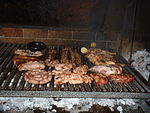
The cuisine of Argentine republic is strongly influenced past Italian and Spanish cuisines and cooking techniques. Ethnic gastronomies derived from groups such as the Quechua, Mapuche, and Guarani have also played a part. There are many regional differences, peculiarly in the provincial states of the northward, west, east and central Argentina, with many plants, fruits and dishes that are not known or barely known in Buenos Aires.
Another determining factor in Argentine cuisine is that Argentina is one of the earth'south major food producers. It is a major producer of meat (especially beef), wheat, corn, milk, beans, and since the 1970s, soybeans. Given the country'due south vast production of beef, red meat is an especially common function of the Argentine diet. Due to the very large number of Argentines of Italian ancestry, pizza and specially pasta are besides very popular, but there are food traditions from other European nations also, including the English language afternoon tea.
Republic of bolivia [edit]

Pique Manlike, one of the main Bolivian dishes.
Bolivian cuisine is the result of Spanish cuisine with infusions of ancient Andean tradition and varies greatly due to the geography of Bolivia. It has been influenced by the Inca cuisine, Aymara cuisine, Spanish cuisine, and to a lesser extent the cuisines of other neighboring countries, similar Argentina and Paraguay. European immigration to Republic of bolivia is not as mutual when compared with other Latin American countries, and while German, Italian, Basque and other cuisines have influenced the cuisine of Republic of bolivia, Spanish cuisine remains the master influence.[17]
In Western Republic of bolivia in the Altiplano, due to the high, cold climate cuisine tends to use spices, whereas in the lowlands of Republic of bolivia in the more Amazonian regions dishes consist of products arable in the region: fruits, vegetables, fish and yuca.[18]
Almuerzo is the most of import meal of the Bolivian 24-hour interval, so much then that daily life tends to revolve around it. Long lunches are traditional throughout the country, so businesses and shops oft shut between the hours of 12 and 2 pm, so that the workers have fourth dimension to return dwelling house for tiffin. A typical Bolivian dejeuner would consist of several courses, including a soup, a principal course of meat, rice, and potatoes, and so a dessert and coffee.[19] Lunch is taken at a leisurely stride and is traditionally followed by a nap, the oft-cited siesta.
Brazil [edit]

The cuisine of Brazil, like Brazil itself, varies greatly by region. Brazilian cuisine can be divided into several distinct locations. From the northward of Brazil through the Amazonian jungle, and direct down the Brazilian coastline.
This diversity reflects the country'south mix of native Amerindians, Portuguese, Africans, Italians, Spaniards, Germans, Syrians, Lebanese and Japanese, among others. This has created a national cooking style marked by the preservation of regional differences.
Coffee, being i of the main agricultural products of Brazil,[20] is an indispensable office of every Brazilian's diet. "Chimarrão,"[ citation needed ] a caffeinated drink fabricated of "erva mate",[ citation needed ] and the super caffeinated "cafezinho" are commonly served at meals, between meals, and for snacks. The average Brazilian drinks 12-24 of these concoctions per day.[21]
Chile [edit]
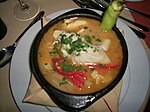
Caldillo de Congrio of Chile
Chilean cuisine stems from the combination of traditional Spanish cuisine with indigenous ingredients.
European immigrants also brought with them diverse styles and traditions in cooking, heavily influencing the cuisine of Chile, including Italian, High german, and French influences also as the English language afternoon tea. These mixtures take created a unique fusion. Seafood is widely used and an array of produce which historically has grown throughout the region have been implemented into Chilean gastronomy. Many recipes are accompanied and enhanced by Chilean wine such as Curanto.
Colombia [edit]

The cuisine of Colombia consists of a large diversity of dishes that take into account the departure in regional climates. For example, in the city of Medellín the typical dish is the bandeja paisa. Information technology includes beans, rice, ground meat or carne asada, chorizo, fried egg, arepa and chicharrón. It is usually accompanied past avocado, tomato plant and sauces.
Inland, the plates resemble the mix of cultures, inherited mainly from Amerindian and European cuisine, and the produce of the country mainly agriculture, cattle, river fishing and other animals' raising. Such is the example of the sancocho soup in Valledupar. Local species of animals like the guaratinaja, part of the wayuu Amerindian culture.
Ecuador [edit]

The food in Republic of ecuador is diverse, varying with distance and associated agricultural weather condition. Ecuadorian cuisine is an amalgamation of Spanish, Andean, and Amazonian cuisines and to a lesser degree Italian, Lebanese, African, and Chinese. Near regions in Ecuador follow the traditional 3 course meal of sopa/soup and segundo/second dish then dessert and a coffee are customary. Dinner is usually lighter and sometimes just coffee or agua de remedio/herbal tea with bread.
Beef, chicken, and seafood are pop in the coastal regions and are typically served with carbohydrate-rich foods, such as rice accompanied with lentils, pasta, or plantain, whereas in the mountainous regions pork, craven, beefiness and cuy (guinea pig) are popular and are oftentimes served with rice, corn, or potatoes.
Some of the typical dishes in the littoral region are: a variety of ceviches, pan de yuca (cassava bread), corviche (plantain, peanut and fish dumplings), guatita, encebollado (fish, cassava and onion stew), empanada de viento (deep-fried flour empanada with cheese filling, served sprinkled with sugar), empanada de verde (green plantain empanada with cheese filling), mangrove crab, arroz con menestra (lentil or bean stew and rice) con asado, caldo de bola (beef soup featuring a green plantain ball filled with meat, egg, and spices). Local staples are rice, plantains and a great variety of seafood.
Typical dishes in the mountain region include: hornado, fritada, humitas, tamales, llapingachos, lomo saltado, and churrasco. Pork, craven, beef, and cuy (guinea grunter) are popular in the mountain regions and are served with a variety of grains (especially rice and corn or potatoes). A popular street food in mountain regions is hornado, consisting of potatoes served with roasted sus scrofa. Fanesca, a fish soup including several types of bean, is oftentimes eaten during Lent and Easter. During the week before the commemoration of the deceased or All Souls' 24-hour interval, the fruit drink colada morada is typical, accompanied by t'anta wawa which is stuffed bread shaped like children.
In the rainforest, a dietary staple is the yuca, elsewhere called cassava. The starchy root is peeled and boiled, fried, or used in a diverseness of other dishes. Across the nation it is besides used as a staff of life, pan de yuca, which is analogous to the Brazilian pão de queijo and its oft consumed alongside different types of drinkable yogurt "yogur persa" brought by Persian immigrants.
Chifa (from the Mandarin words 吃饭, meaning "to eat rice") Ecuadorian-Chinese fusion food is a mainstay of Ecuadorian cuisine.
Paraguay [edit]

The cuisine of Paraguay is the set of dishes and culinary techniques of Paraguay. Much similar its neighboring countries, Paraguayan cuisine is a fusion of Indigenous cuisine (Guaraní), Spanish cuisine and international cuisines from those who have immigrated over the years. Meat, particularly beef, is a staple of the Paraguayan nutrition. This is reflected in the Asado, a series of barbecuing practices and the social consequence that are traditional to Argentine republic, Uruguay, and Paraguay.
The cuisine of Paraguay includes unique dishes such as sopa paraguaya, kiveve prepared using a pumpkin, also known every bit "andai", or Chipa Guasú. Chipa Guasú, an original dish to Paraguay, is a cake made with corn grains that is at present widely served in Northeastern Argentina equally well. The national drink of Paraguay is known equally terere, in addition to fruit juices and soft drinks being very common throughout the state. Yucca and corn are two important ingredients in Paraguayan cuisine[5]
Peru [edit]
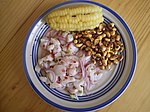
Republic of peru has a varied cuisine with ingredients similar irish potato, uchu or Ají (Capsicum pubescens), oca, ulluco, avocado, fruits similar chirimoya, lúcuma and pineapple, and animals like taruca (Hippocamelus antisensis), llama and guinea sus scrofa (chosen cuy). The combination of Inca and Castilian culinary traditions, resulted in new meals and ways of preparing them. The inflow of Africans, Chinese and Japanese immigrants in the 19th century also resulted in the evolution of Creole cuisine in the metropolis of Lima, where the vast majority of these immigrants settled.
Some typical Peruvian dishes are ceviche (fish and shellfish marinated in citrus juices), the chupe de camarones (a soup fabricated of shrimp (Cryphiops caementarius)), anticuchos (cow's heart roasted en brochette), the olluco con charqui (a goulash dish made of ulluco and charqui), the Andean pachamanca (meats, tubers and broad beans cooked in a rock oven), the lomo saltado (meat fried lightly with tomato plant and onion, served with french fries and rice) that has a Chinese influence, and the picante de cuy (a casserole dish fabricated of fried republic of guinea pig with some spices). Peruvian food can be accompanied by typical drinks like the chicha de jora (a chicha fabricated of tender corn dried by the sunday). There are likewise chichas made of peanuts or regal corn, known as chicha morada.
Uruguay [edit]
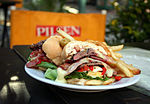
The cuisine of Uruguay is traditionally based on its European roots, peculiarly from Italy, Spain, France, Portugal, Federal republic of germany and Britain. Many foods from those countries such equally pasta, sausages, and desserts are mutual in the nation's nutrition. The Uruguayan barbecue, asado, is 1 of the most exquisite and famous in the globe. A sugariness paste, Dulce de Leche is the national obsession, used to fill cookies, cakes, pancakes, milhojas, and alfajores.
The base of the country's diet is meat and brute products: primarily beef just besides chicken, lamb, grunter, and sometimes fish. The preferred cooking methods for meats and vegetables are still boiling and roasting, although modernization has popularized frying (run into milanesas and chivitos). Meanwhile, wheat and fruit are generally served fried (torta frita and pasteles), comfited (rapadura and ticholos de banana), and sometimes baked (rosca de chicharrones), a new modern style. Bushmeat comes from mulitas and carpinchos. Regional fruits like butia and pitanga are commonly used for flavoring caña, along with quinotos and nísperos.
Venezuela [edit]

Arepas of Venezuela with chicken schnitzel, avocado, mayonnaise and blood-red onion.
Due to its state, diversity of agronomical resources, and the cultural diversity of the Venezuelan people, Venezuelan cuisine oftentimes varies greatly from one region to another. Its cuisine, traditional besides as modern, is influenced by its European, West African and Native American traditions. Food staples include corn, rice, plantain, yams, beans and several meats. Potatoes, tomatoes, onions, eggplants, squashes, spinach and zucchini are also common sides in the Venezuelan diet. Venezuela has several representative national dishes such as the arepa (a corn based breadstuff similar patty), pan de jamón, tequeño, pabellón criollo and the hallaca at Christmas time.
Traditional eating customs [edit]
There are many different kinds of traditions associated with eating in Latin America. There are a diverseness of special days where sure foods are consumed, besides as many holidays that are celebrated in Latin America.
Traditions [edit]
There are many forms of gratitude that inhabitants of Latin America use when they discard excess nutrient. Some people osculation the bread while others cut it before discarding it.[22] Other such traditions are upheld largely by the state, Argentina and Uruguay accept one such tradition known every bit a "es:Ñoquis del 29" or "the Gnocchi 29", where on the 29th of each calendar month a family eats gnocchi, sometimes placing money under their plate to wish for abundance in the next month.
There is a holiday celebrated in Latin America known equally Iii Kings Day (otherwise known every bit Epiphany) which is celebrated on January 6 of each year where families banquet in laurels of God's manifestation in human being class in Jesus.
In many countries of Latin America families eat lentils on the first day of the New year considering they are thought to bring prosperity.
Run across also [edit]
- Latin American civilisation
- List of cuisines
- Louisiana Creole cuisine
- Native American cuisine
- Aztec cuisine
- Inca cuisine
- Maya cuisine
- North American cuisine
- South American cuisine
- Spanish cuisine
References [edit]
- ^ Spivey, Diane M. (2006). Palmer, Colin (ed.). "Latin American and Caribbean Food and Cuisine". Encyclopedia of African-American Civilization and History. Detroit: Macmillan Reference. 2: 838–844.
- ^ a b Food cultures of the globe encyclopedia. Santa Barbara, Calif.: Greenwood. 2011. pp. 165–171, 476. ISBN9780313376276 . Retrieved September 25, 2016.
- ^ Spivey, Diane M. "Latin American and Caribbean area Nutrient and Cuisine." Encyclopedia of African-American Civilisation and History. Ed. Colin A. Palmer. second ed. Vol. 2. Detroit: Macmillan Reference United states of america, 2006. 838-844. Gale Virtual Reference Library. Web. 26 Sept. 2016.
- ^ Reporter'due south Notebook. York Daily Record (York, Pennsylvania). 15 Dec 2003. Folio 35. Accessed 24 January 2021.
- ^ a b Albala, Ken (2011). Nutrient Cultures of the World Encyclopedia . Santa Barbara, CA: Greenwood. pp. 255. ISBN9780313376276 – via eBook.
- ^ Taylor, David West.; Anderson, Gregory J. (2014). "Primal plants preserve elements of civilisation: A study over distance and fourth dimension of fresh crops in Puerto Rican markets in Hartford, Connecticut, "A moveable feast"". American Periodical of Phytology. 101 (4): 624–636. doi:10.3732/ajb.1300287. PMID 24688056.
- ^ Colondres, Doreen (Nov 23, 2015). La cocina no muerde: Un recorrido por nuestras tierras y más de 100 recetas para tu mesa (in Spanish). Penguin Random House Grupo Editorial U.s.. ISBN978-1-941999-47-9.
- ^ Hernández, Perla Alessandra. "Chef Doreen Colondres visita la isla para ofrecer talleres de cocina". Sabrosia Puerto Rico (in Spanish). Retrieved Jan 7, 2022.
- ^ "Gastronomy in Central America, a pleasure for the senses". November 23, 2017.
- ^ Mann, Charles C. 1491: Revelations of the Americas before Columbus. Vinton Press. 2005. pp. 196–97.
- ^ a b "Try the culinary delights of Nicaragua cuisine". Nicaragua.com. Retrieved May eight, 2006.
- ^ "Ethnic Food of Panama". Retrieved September 26, 2016.
- ^ Albala, Ken (2011). Food cultures of the world encyclopedia vol. 2. Santa Barbara, Calif.: Greenwood. pp. 601–602. ISBN9780313376276.
- ^ "Traditional Mexican cuisine - ancestral, ongoing community civilisation, the Michoacán prototype - intangible heritage - Culture Sector - UNESCO". world wide web.unesco.org . Retrieved October vi, 2016.
- ^ "There's more to Tex-Mex than meets the palate | The Center for the Humanities | Oregon State University". oregonstate.edu . Retrieved Oct 6, 2016.
- ^ Albala, Ken (2011). Food Cultures of the World Encyclopedia . Greenwood. pp. 217. ISBN9780313376276.
- ^ Roufs, Timothy Yard.; Roufs, Kathleen Smyth. Sweet Treats Effectually the World. p. 44.
- ^ "A Guide to Bolivia'southward Most Mouthwatering Foods". Bolivian Life . Retrieved October six, 2017.
- ^ Traditional Cuisine. republic of bolivia-guide.com Retrieved 2012-03-22
- ^ "The CIA World Factbook". September 29, 2021.
- ^ "Brazilian cuisine". Vegetarian Journal. 21 (2).
- ^ Lamberto, Luciana. "Customs and Traditions: How We Eat in Latin America". www.quericavida.com. Que Rico Vida. Retrieved September 24, 2016.
mccutcheontrainsomill.blogspot.com
Source: https://en.wikipedia.org/wiki/Latin_American_cuisine
0 Response to "â€å“ollaã¢â‚¬â a Soup Made With Beef Broth, Squash, Yucca and Common Central American Vegetables."
Post a Comment